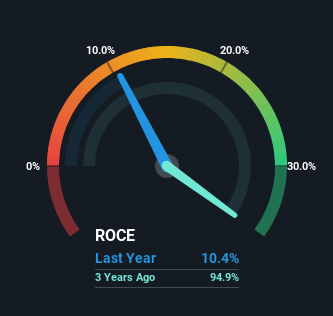If you're not sure where to start when looking for the next multi-bagger, there are a few key trends you should keep an eye out for. Firstly, we'd want to identify a growing return on capital employed (ROCE) and then alongside that, an ever-increasing base of capital employed. If you see this, it typically means it's a company with a great business model and plenty of profitable reinvestment opportunities. Speaking of which, we noticed some great changes in PC Partner Group's (HKG:1263) returns on capital, so let's have a look.
What Is Return On Capital Employed (ROCE)?
For those who don't know, ROCE is a measure of a company's yearly pre-tax profit (its return), relative to the capital employed in the business. The formula for this calculation on PC Partner Group is:
Return on Capital Employed = Earnings Before Interest and Tax (EBIT) ÷ (Total Assets - Current Liabilities)
0.10 = HK$307m ÷ (HK$5.0b - HK$2.1b) (Based on the trailing twelve months to December 2024).
So, PC Partner Group has an ROCE of 10%. On its own, that's a standard return, however it's much better than the 5.4% generated by the Tech industry.
Check out our latest analysis for PC Partner Group

While the past is not representative of the future, it can be helpful to know how a company has performed historically, which is why we have this chart above. If you'd like to look at how PC Partner Group has performed in the past in other metrics, you can view this free graph of PC Partner Group's past earnings, revenue and cash flow.
What The Trend Of ROCE Can Tell Us
Investors would be pleased with what's happening at PC Partner Group. Over the last five years, returns on capital employed have risen substantially to 10%. The company is effectively making more money per dollar of capital used, and it's worth noting that the amount of capital has increased too, by 191%. This can indicate that there's plenty of opportunities to invest capital internally and at ever higher rates, a combination that's common among multi-baggers.
In another part of our analysis, we noticed that the company's ratio of current liabilities to total assets decreased to 41%, which broadly means the business is relying less on its suppliers or short-term creditors to fund its operations. This tells us that PC Partner Group has grown its returns without a reliance on increasing their current liabilities, which we're very happy with. However, current liabilities are still at a pretty high level, so just be aware that this can bring with it some risks.
The Bottom Line On PC Partner Group's ROCE
A company that is growing its returns on capital and can consistently reinvest in itself is a highly sought after trait, and that's what PC Partner Group has. And with the stock having performed exceptionally well over the last five years, these patterns are being accounted for by investors. In light of that, we think it's worth looking further into this stock because if PC Partner Group can keep these trends up, it could have a bright future ahead.
If you want to know some of the risks facing PC Partner Group we've found 4 warning signs (2 shouldn't be ignored!) that you should be aware of before investing here.
If you want to search for solid companies with great earnings, check out this free list of companies with good balance sheets and impressive returns on equity.
New: Manage All Your Stock Portfolios in One Place
We've created the ultimate portfolio companion for stock investors, and it's free.
• Connect an unlimited number of Portfolios and see your total in one currency
• Be alerted to new Warning Signs or Risks via email or mobile
• Track the Fair Value of your stocks
Have feedback on this article? Concerned about the content? Get in touch with us directly. Alternatively, email editorial-team (at) simplywallst.com.
This article by Simply Wall St is general in nature. We provide commentary based on historical data and analyst forecasts only using an unbiased methodology and our articles are not intended to be financial advice. It does not constitute a recommendation to buy or sell any stock, and does not take account of your objectives, or your financial situation. We aim to bring you long-term focused analysis driven by fundamental data. Note that our analysis may not factor in the latest price-sensitive company announcements or qualitative material. Simply Wall St has no position in any stocks mentioned.
About SEHK:1263
PC Partner Group
An investment holding company, designs, develops, manufactures, and sells computer electronics.
Flawless balance sheet established dividend payer.
Market Insights
Community Narratives



